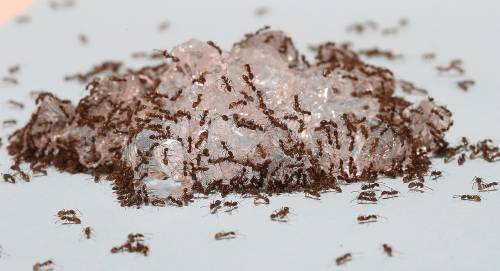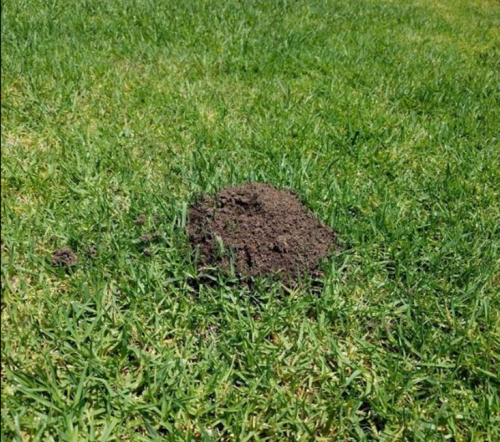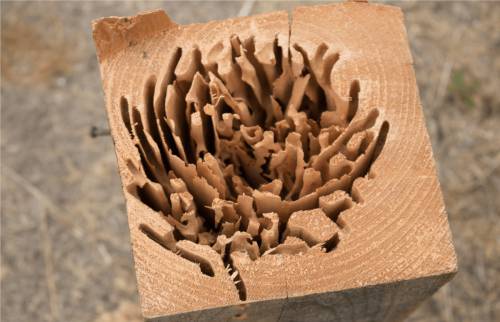Problems Caused By Ants
|
|
Pomerix staff
Published: 8-May-2023
Updated on: 13-May-2023
|
Ants are important pests in agricultural and urban areas and can cause problems in so many different ways. Here, we will provide an overview of some of these problems.
Nuisance
Ants are a nuisance to homeowners, farmers, and property managers, as they can invade homes, gardens, agricultural fields, and business offices. Ants can crawl on many vertical and horizontal surfaces such as tree trunks, leaves and stems, soil, and irrigation pipes indoors, and floors, walls, kitchen countertops, pantry, bathroom, and kitchen sinks, and so on. They can even crawl on people’s faces and bodies, making them even more annoying. Nobody enjoys seeing an army of ants in their home.
Damage to stored food
Ants can quickly locate and steal stored food from kitchens and in commercial spaces. Not only they can steal food, they also contaminate the food by laying down pheromones and dropping fecal matter, making the food unpalatable. Furthermore, ants are capable of contaminating food by harboring and transmitting bacteria, yeasts, and molds. If infested, stored food in homes and commercial food storage may have to be disposed of, leading to financial loss.
Protection of sap-feeding insects
Ants also tend and protect sap-feeding insects such as aphids, mealybugs, and scale insects. Through their mutualistic behavior, they protect these pests from natural enemies such as lady beetles, parasitic wasps, and hoverfly larvae, in exchange for honeydew. This mutualistic behavior is extremely detrimental to any garden and agricultural plant since it gives sap-sucking insects a much higher chance of survival and faster reproduction. When these plant pests get dislodged from their host plant through the action of storms or high-pressure water spraying, ants can bring them back onto the leaves to start their feeding activity again.
Stinging
There are even ants that sting people and can cause pain, itching, discomfort, and in some rare cases an anaphylactic shock. These ants are especially problematic at school sites and any place where young children play. Stinging ants inject venom into their victim which can create long-lasting symptoms such as itching, pain, discomfort, skin rash, etc. Examples of stinging ants include harvester ants, big-headed ants, and fire ants. Harvester ants are particularly well adapted to living in dry sandy environments. These ants gather and store seeds in their nests. They are also known for their painful sting. Big-headed ants also sting to defend themselves against intruders.
Fire ants are diverse and include the common Southern fire ant and the infamous red imported fire ant also known as RIFA. RIFA is an important public health concern for its ability to sting and inject venom into the skin of humans, pests, birds, and any other animals. Their venom produces a wide range of reactions in people ranging from localized pain and swelling to anaphylactic shock and death. Its venom has an alkaloid nature which exhibits strong tissue-killing or necrotoxic activity. Necrotoxin is a toxin that kills tissue cells. The toxin is responsible for the pain and white pustules that appear after stinging. The pustules may appear shortly or after a few hours or a even few days after stinging. It is important to note that not all people react the same way to RIFA’s venom. This is similar to the bed bug biting reaction which can differ significantly from person to person.
Attacking beehives
Some ant species such as the red imported fire ant (Solenopsis invicta) can raid beehives in search of food. They can steal honey, pollen, and even brood from the colony. Argentine ants also take advantage of the sugary and protein content of beehives. Healthy beehives can put up a strong defense against invading ants, but they can get overwhelmed by the sheer number of ants attacking their beehive. Ants can also transmit deadly viruses such as deformed wing virus (DWV) to bees.
Making mounds
Many ants species create mounds in soil. Some species such as many harvester ants and pyramid ants create mounds in dry soil such as infield areas of baseball and softball fields. Other species, such as the red imported fire ants create mounds in lawns, damaging their aesthetic values. Fire ant mounds can also make mowing more difficult and more dusty. As mowers pass over a fire ant mound, they hit the soil which scatters a lot of loose soil around and disturbs the fire ants. Fire ants will quickly come out of the mound to attack.
Damage to electrical equipment
Some ant species such as the Caribbean crazy ant (Nylanderia pubens) may nest inside electrical equipment causing damage and power outages. Some ant species such as the red imported fire ant is attracted to electrical fields and are commonly found nesting in traffic lights, and various electrical power boxes and can cause damage to such equipment. Some of these boxes provide an excellent shelter for these fire ants, protecting them against the elements and making them a preferred site for building their nest.
Altering biodiversity and natural environments
Some species such as the RIFA and yellow crazy ant (Anoplolepis gracilipes) can alter natural ecosystems by preying on native fauna or by displacing other ant species. For example, the yellow crazy ant has reportedly killed millions of native land crabs in Christmas Island, Australia. Land crabs in Christmas Island are keystone species that fertilize the soil by digging holes in the ground. Other species such as RIFA impose a serious threat to the existence of some bird species such as the northern bobwhite, a quail species. Research has shown that in areas where fire ant populations are under control, bobwhites have a higher survival compared to non-treated areas infested with RIFA.
Wood damage
In addition to all the problems mentioned above, some species such as carpenter ants are known to cause structural damage to wooden houses by burrowing in and out of the wood. These ants are considered Wood Destroying Organisms (WDO) and can make significant damage to structural wood in studs, rafters, beams, door, and windows frames, etc. It’s important to remember that, unlike termites, wood-destroying ants do not feed or digest the wood but rather chew on it to create galleries for their nest. Carpenter ants and velvety tree ants are examples are wood destroying ants. Carpenter ants are large and are diverse with over 1,000 species worldwide.


